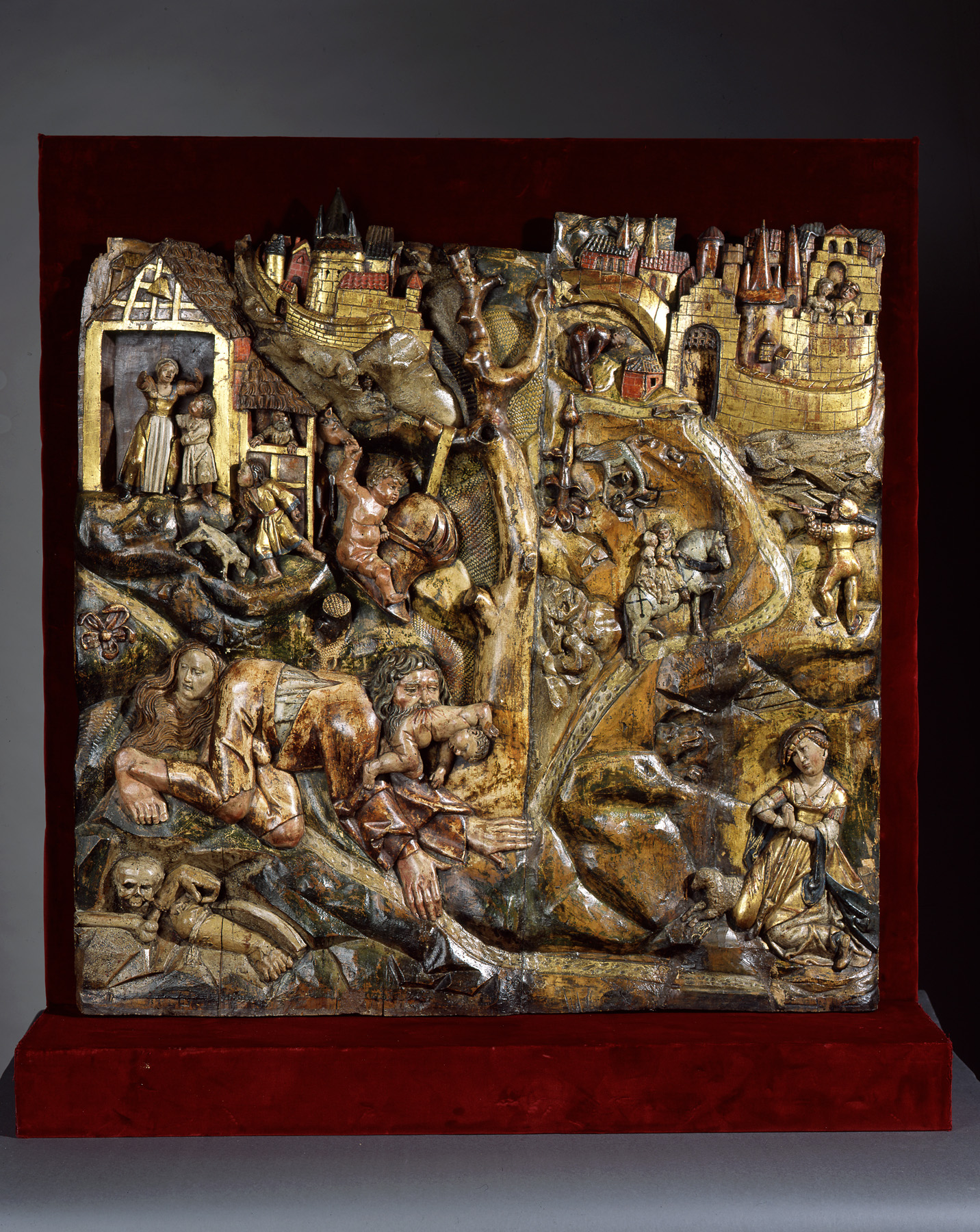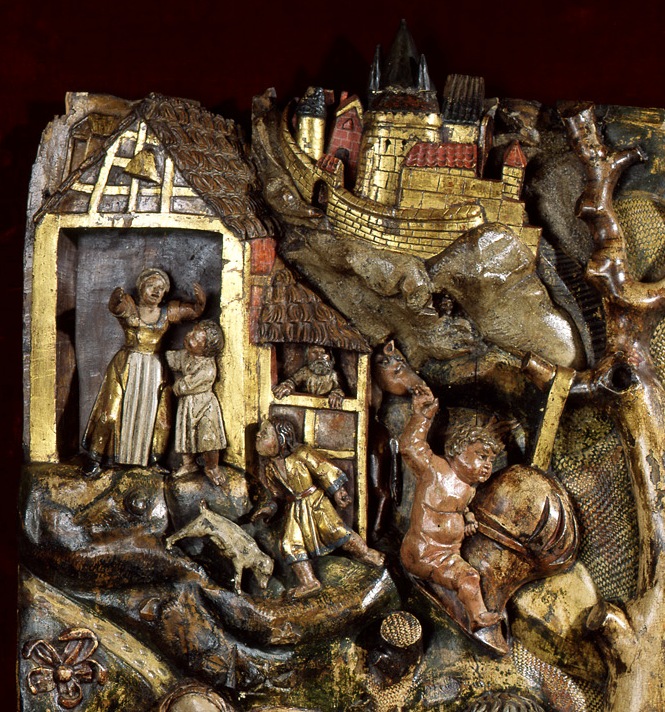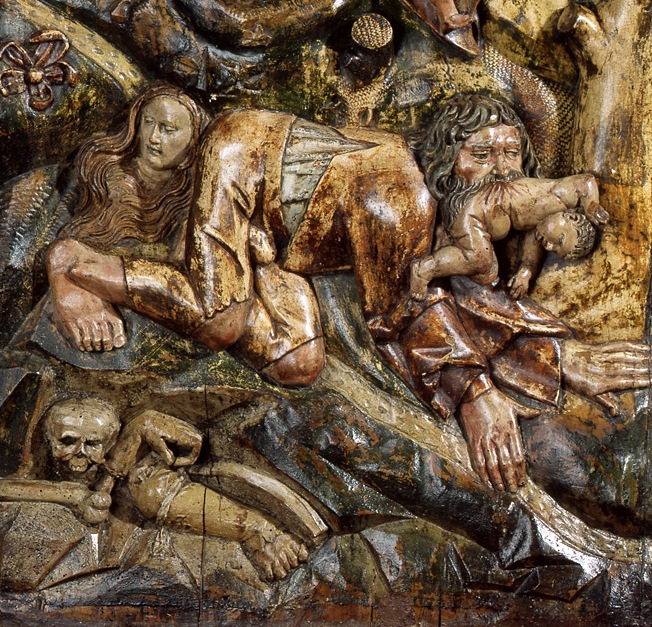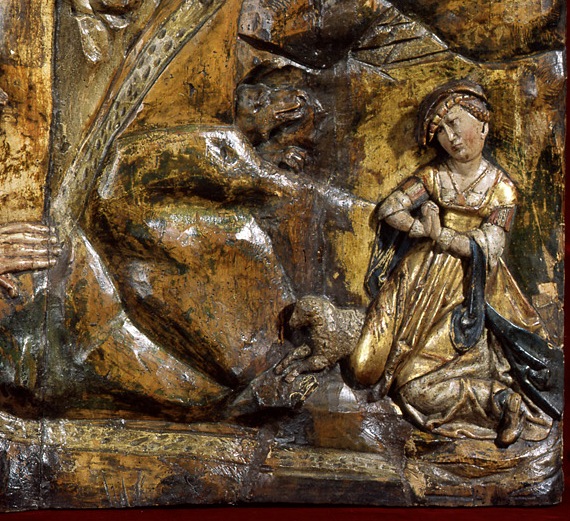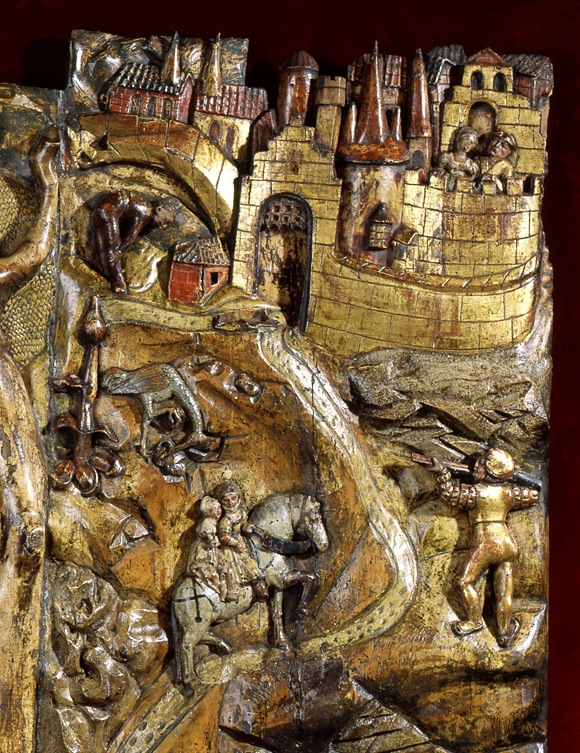Description
This surprising low-relief, in a very fine condition, was made during the 16th century probably in Würtzburg in the Main Valley, Lower-Franconia where a characteristic school of sculpture flourished from the mid-15th century onwards.
The left-hand side of our low-relief depicts the legend of the werewolf.
In a farm’s courtyard, an unkempt man eats a child. Crawling like an animal, the man is shown turning into a voracious creature that catches and kills everything around him.
Several victim’s body parts are lying around him testifying of its regular attacks.
In the background, a mother raises her arms in despair while her two other children seek refuge by her sides. A man is watching the scene, safely sheltered in a stable.
Further in the back appears a large city.
The right-hand side of the panel represents the legend of Saint George.
The young Trébizonde, born a princess, lavishly dressed, is depicted in the bottom part of the low-relief, praying on her knees. She is kept in cavern by a dragon, of whom we can only see the head. The lady is the last victim the dragon has asked for. Indeed the lamb beside Trébizonde points her out as sacrifice.
On the tortuous path, Saint George is riding a white horse with the princess he freed from the monster. Trébizonde’s parents brings are awaiting for them from the top of a tower.
The crossbowman on the right evokes Saint George’s fight against the dragon.
This low-relief was made after to woodcuts by Lucas Cranach the Elder (1472-1553).
The first one is the famous “Der Werwolf” (162×126 mm), produced by the artist himself around 1512. One exemplar of this engraving is kept in the Cabinet des Estampes in Strasbourg (France). This woodcut has inspired the left-hand part of our low relief.
With no other equivalent in the work of Lucas Cranach the Elder and quite rare in the iconography of this period this peculiar picture might have found inspiration in one of Ovid’s Metamorphoses, the king Lycaon turned into a wolf by Jupiter (Cat n° IV 1). In medieval stories and sermons, such as Geyler de Kaisersberg’s, the werewolf is defined as a savage man, embodying animal’s primitive instincts and danger. As such he was closely related to the devil.
“Der Werwolf” had a mirror woodcut depicting Saint George killing the dragon. This image has inspired the right side of our low relief and sheds a new light on the panel’s symbolic meaning.
The panel is divided by leafless tree in two distinct parts, highlighting the antagonism between man and animal. The animal’s bestiality and foul instincts and on the other side the civilised man embodied by Saint George. He stands as the miles christianus that is the Christian knight.
Indeed Saint George was adopted as patron saint by the crusaders in the Holy Land after the siege of Antioch in 1097. From then on Saint George was considered a model of chivalrous virtues.
A social reading of these woodcuts and of this low-relief must also be done:
Cranach the Elder was Frederick III elector of Saxony’s court painter. While Saint George is the patron saint of the nobility he also acts as a model of virtue for the peasants. Plus on the background, the high perched castle gives a topographic and symbolic vision of the elector’s leading role.
Saint George was also the patron saint of archers and crossbowmen, armourers and feather workers (making the plumes of the knight’s helmets). We can see depictions of those artisans just above the princess.
From the 16th century onwards the worship of Saint George and its ideal of chivalry fades away with the increase of gun’s use and the loss of single combat’s practice.
In 1972, to celebrate the 500th birth anniversary of Lucas Cranach the Elder a travelling exhibition showcasing the most famous works of the artist was produced. This woodcut Der Werwolf -reminiscence of Albrecht Dürer’s Vision of Saint Eustace- was part of this exhibition which went through the following cities:
– Museum of Bielefeld (23.01 – 26.03.72)
– Kunstmuseum Düsseldorf (08.04 – 17.05.72)
– Wallraf-Richartz-Museum Köln (26.05 – 16.07.72)
– Kunstsammlungen der Veste Coburg (16.07 – 30.09.72)
Our low-relief was also exhibited during the exhibition El Salvaje Europeo at the Bancaja Foundation of Valencia and at the Contemporary Cultural Center of Barcelona in 2004. The picture appears in the catalogues, p.18-19 of “El Salvaje Europeo” (Valencia, Spanish language) and p.14 of “El Salvatge Europeu” (Barcelona, Catalan language).
The low-relief also featured in the story “Beaux objets sur le marché” from L’ Œil magazine dated December 1965 – N°132, p.48-49.
Literature
Hommeanimal. Histoires d’un face à face, cat. Exp. Strasbourg, musée archéologique, galerie Heitz, musée de l’œuvre Notre-Dame, Musée d’art moderne et contemporain, 7 avril 2004-4 juillet 2004, Musées de Strasbourg, Adam Biro, 2004.
Represented in Cranach in Coburg, Graphik von Lucas Cranach d. Ä., Lucas Cranach d. J. und der Werkstatt im Kupferstichkabinett der Kunstsammlungen der Veste Coburg, Stefanie KNÖLL, Meike LEYDE, Michael OVERDICK (Hg.), Editions Schnell Steiner, august 2020, page 313

